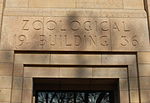Como Park Zoo and Conservatory
1873 establishments in MinnesotaAC with 0 elementsAmusement parks in MinnesotaArt Deco architecture in MinnesotaBotanical gardens in Minnesota ... and 8 more
Greenhouses in MinnesotaJapanese gardens in the United StatesNational Register of Historic Places in Saint Paul, MinnesotaParks in Saint Paul, MinnesotaProtected areas of Ramsey County, MinnesotaRegional parks in MinnesotaWorks Progress Administration in MinnesotaZoos in Minnesota

The Como Park Zoo and Marjorie McNeely Conservatory (or just Como Zoo and Conservatory) are located in Como Park at 1225 Estabrook Drive, Saint Paul, Minnesota. The park, zoo and conservatory are owned by the City of Saint Paul and are a division of Saint Paul Parks and Recreation. Its attractions include the zoo, the conservatory, an amusement park, a carousel, Lake Como, a golf course, a pool and more. The park receives more than 1.9 million visitors annually. Como Park is a free park and while no admission fee is charged for the zoo or conservatory, voluntary donations of $4 per adult and $2 child are suggested.
Excerpt from the Wikipedia article Como Park Zoo and Conservatory (License: CC BY-SA 3.0, Authors, Images).Como Park Zoo and Conservatory
Kaufman Drive, Saint Paul Como Park
Geographical coordinates (GPS) Address Website External links Nearby Places Show on map
Geographical coordinates (GPS)
| Latitude | Longitude |
|---|---|
| N 44.981397 ° | E -93.150807 ° |
Address
Como Park Zoo and Conservatory
Kaufman Drive
55103 Saint Paul, Como Park
Minnesota, United States
Open on Google Maps








